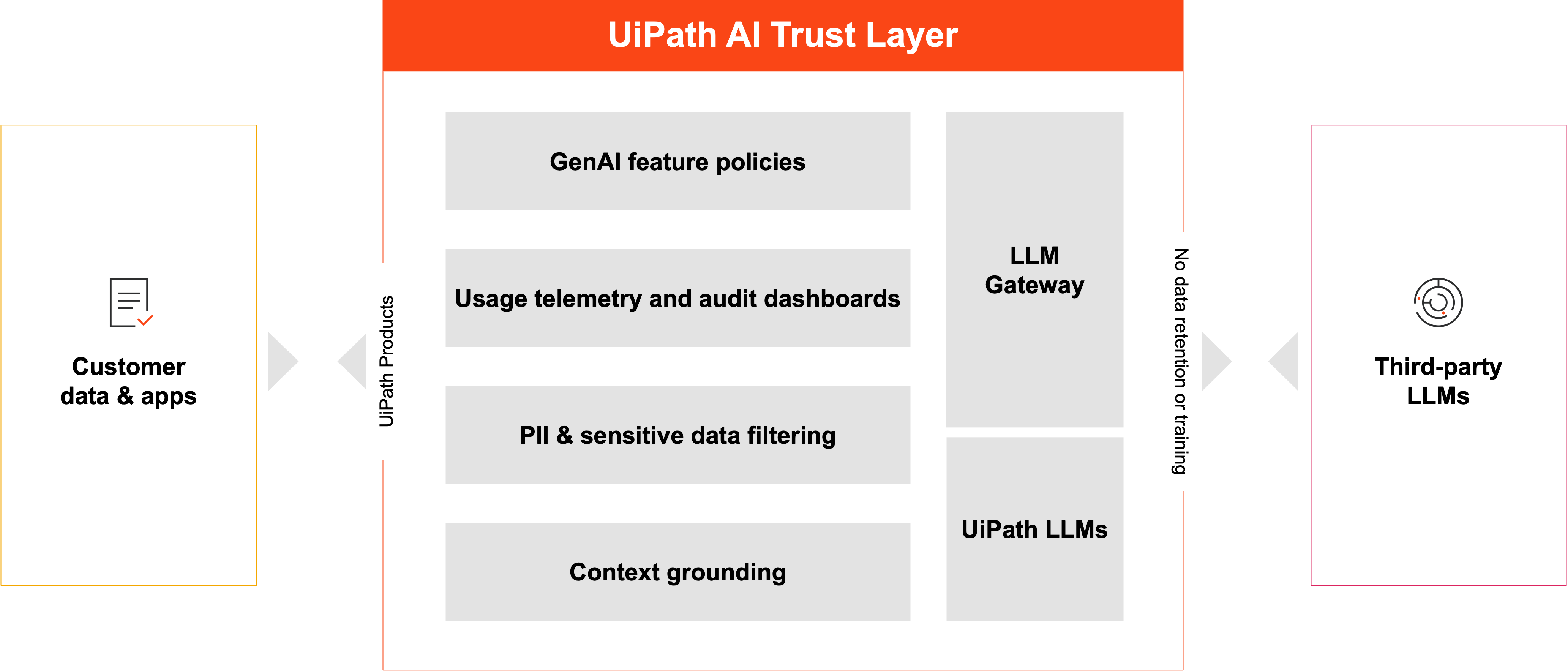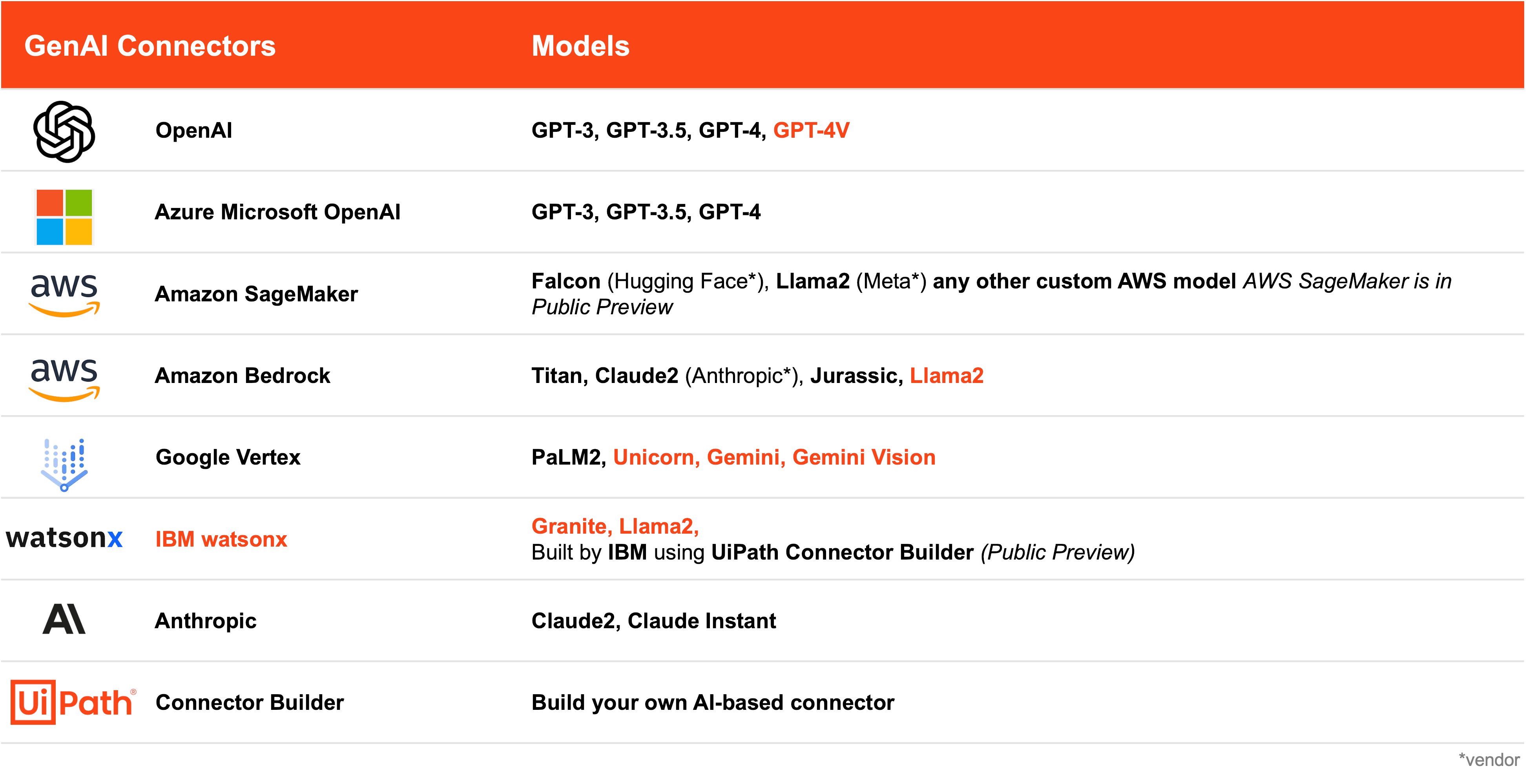Business leaders are done treating generative AI like a gimmick. They want to use the latest large language models (LLMs) to drive transformative change, concrete results, and new operating models that disrupt their market and grow their bottom lines. They’re ready for AI at work…that really works.
At the UiPath AI Summit, we showed how automation is the catalyst for AI success. However, as the leader of your business, you need more than a toolbox. You need the vision, strategy, and skill set to use those tools effectively.
As I discussed with Rowan Curran, Senior Analyst at Forrester, during our opening keynote, leaders seeking to embed AI across their enterprise must keep three things top of mind:
-
Business context
-
Access to a diverse set of models
-
Actionability
And, of course, trust underpins everything. Trust is hard-won from customers and easily lost, so leaders seeking to harness AI must proceed carefully to ensure they don’t betray their customers’ confidence. That’s why trust is foundational to the UiPath Business Automation Platform and underlies all our announcements at AI Summit.
I’ll go into more detail and show you how to actualize the potential of AI for your business. Here’s my major takeaways from UiPath AI Summit 2024—our formula to turn AI potential into business results:
1. Feed your AI models the right context with context grounding
Business leaders seeking to leverage the latest AI models have a powerful ‘brain’ for business at their disposal with generative AI. But genius can’t exist in a vacuum. AI won’t enhance your bottom line until it understands your business and its unique context.
Businesses need a safe, reliable, low-effort way to use their business data with AI models. Our addition of context grounding to the UiPath AI Trust Layer does just that.
UiPath context grounding helps businesses educate generative AI models by feeding a foundation of business context when users submit their prompts. We do this through retrieval augmented generation (RAG), a system that extracts relevant information from a large dataset, like a company’s knowledge base, and then uses that information to create accurate and insightful responses.
Context grounding makes data LLM-ready by converting it to an optimized format (embeddings) that can easily be indexed, searched, and injected into prompts to improve generative AI predictions. AI responses will be more accurate, domain-specific, and significantly less prone to producing misleading outputs, sometimes called ‘hallucinations.’ The result? More trustworthy models and greater value from your GenAI-powered automations.

2. Choose and deploy the best AI in class for every task
AI encompasses a large number of different systems and models. General-purpose generative AI models like GPT-4 and Gemini struggle to match the performance and accuracy of models specially trained for a specific task. Business leaders must recognize that there’s no single ‘AI model to rule them all’. Their enterprise will need to leverage a diverse selection of AI models—the best in class for every task—to achieve their full potential.
Think of it this way: your engineering team might be world-class, but would you ask them to process your company’s invoices? Every business must leverage a mixture of different skills and competencies to cover all bases and achieve top performance. They must take a similar approach to AI. In this context, UiPath gives customers access to powerful, specialized AI models tailored to their challenges and most valuable use cases.
That’s why we introduced our UiPath LLMs:
-
UiPath DocPath will help businesses process any document out-of-the-box, including lengthy and unstructured data and tables.
-
UiPath CommPath can process diverse communications, from transactional messages to complex requests containing multiple requests and context-specific language.
Combining the best of generative AI and specialized AI, the UiPath family of LLMs empowers businesses to understand and process any document and a huge variety of message types. Instead of relying on imprecise and time-consuming prompt engineering, UiPath DocPath and CommPath give businesses extensive tools to customize AI models to their exact requirements.
DocPath and CommPath are just the beginning of our proprietary LLMs, but they already deliver significant benefits:
-
Increased accuracy of models tailored for diverse document and message types. UiPath DocPath delivers a 45-76% error rate reduction in data extraction, and 30-65% fewer errors when extracting from complex tables, compared to market-leading generative AI models.
-
Accelerated time to value thanks to reduced training effort and improved human in the loop fine-tuning. UiPath CommPath delivers 2-3x less training effort for the same accuracy compared to traditional data annotation. DocPath offers a 10x reduction in training effort, with some use cases requiring no annotation at all.
-
Enterprise control due to robust security, compliance, and governance, paired with superior guardrails compared to generative AI processing.
We also unveiled many new generative AI connectors, allowing businesses to harness the best AI models for their needs and apply them to automations across the UiPath Platform:

Our connectors empower customers to harness the latest GenAI capabilities. For example, the addition of vision in GPT-4V enables automations that can analyze and act based on image inputs. And our Unicorn connector provides easy access to the most advanced text model in the PaLM family, helping to automate complex tasks based on language and conversation.
Join our Connector Corner webinar to see how UiPath Integration Service enables seamless AI integration and enhanced operational efficiency.
3. Give your AI the power to act and make an impact
If AI is the brain, then automation is the body. Automation provides AI with the integrations, data, context, and—crucially—the ability to take action in the enterprise. To make changes and successfully carry out key business processes, they need to synchronize and work together.
UiPath is constantly innovating to find new ways to integrate AI and automation. At the UiPath AI Summit, we were very proud to announce that UiPath Autopilot™ for Developers and Testers will be entering general availability in June.
UiPath Autopilot™ is the perfect partner to drive AI-powered automation. It combines generative AI and specialized AI, in a simple conversational interface, to enhance productivity and democratize automation across the enterprise.
The Autopilot experience for developers and testers levels up efficiency in UiPath Studio, Apps, and Test Suite. With it, your developers and testers can:
-
Create automations, apps, and Visual Basic expressions with simple conversational language
-
Convert legacy paper forms and PDFs to automation-powered apps
-
Get contextual ‘next best action’ guidance as you’re building automations
-
Generate, automate, and gain insights from your test cases
The advancement of UiPath Autopilot™ continues to make using AI and automation easier and more impactful throughout the enterprise. It’s the perfect enabler, not just of AI-powered automation, but also AI powered by automation as well.
My UiPath favorites are Autopilot and coded automations, which have been a game-changers in how I approach automation projects. It’s not just about ensuring the reliability of automated processes but also about instilling confidence in the solutions we deploy.”
Sai Kiran, UiPath MVP and Senior Automation Developer at Cigniti
Turn AI potential into business reality
The emergence of generative AI represents a paradigm shift for businesses. There’s no way to put the genie back in the bottle. To survive and thrive, enterprises need to quickly adapt to the new reality and learn how to harness the full potential of generative AI.
But the first step is to understand the technology’s limitations. Off-the-shelf, generative AI has a broad, generic understanding of the world, its performance is spotty across different tasks, and it has no capacity to trigger any action in large or complex enterprises.
To maximize AI potential, business leaders need to ground models in the context of their business. They must integrate AI with automation to enable it to take action and make impact. And they need to maintain a diversity of specialized and generative models, ensuring they have the best tool for every task.
UiPath provides a platform where all of this is possible. A platform to turn AI hype into business reality.
This year’s UiPath AI Summit once again proved to be a great success. It served as a forum to showcase various sectors and exhibit a variety of automation and AI capabilities, assuring that each attendee could find the exact information and insights they needed. If you missed this year’s AI Summit—or you want to revisit some of the sessions—all the recordings from the summit are available for you to watch at your convenience.


